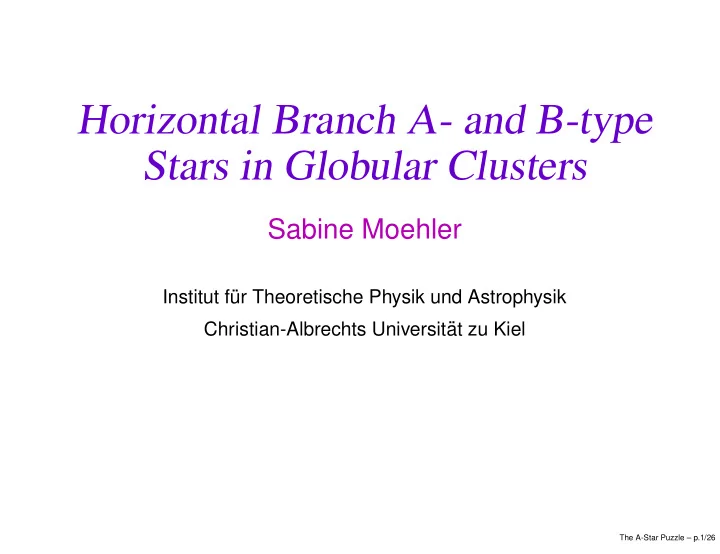

Horizontal Branch A- and B-type Stars in Globular Clusters Sabine Moehler Institut f¨ ur Theoretische Physik und Astrophysik Christian-Albrechts Universit¨ at zu Kiel The A-Star Puzzle – p.1/26
� � � � � � � ✁ ✁ Globular Clusters some 10 000 to more than 1 000 000 stars with same age same distance and reddening same initial chemical composition best approximation of physicist’s laboratory large distances faint stars high densities crowding The A-Star Puzzle – p.2/26
� � The Discovery of the Horizontal Branch ten Bruggencate (1927) used data from Shapley (1915) to plot apparent brightness versus colour index first colour-magnitude diagram description of red giant branch (RGB) and a horizontal branch (HB) departing from the RGB and extending over a wide colour range The A-Star Puzzle – p.3/26
The A-Star Puzzle – p.4/26
Modern Colour-Magnitude Dia- gram The A-Star Puzzle – p.5/26
� � � � � How to become a Horizontal Branch Star Hoyle & Schwarzschild (1955): HB stars are post-RGB stars with helium core burning Sandage & Wallerstein (1960): HB becomes bluer with decreasing metallicity Faulkner (1966): first zero-age HB models that become bluer with decreasing metallicity no mass loss assumed high helium abundance Y = 0.35 required The A-Star Puzzle – p.6/26
✄ ✂ ✠ ✝ ☎✆ ✟ ✄ Mass Loss appears on the Stage (Iben & Rood, 1970) “In fact for the values of Y and Z most favored (Y 0.25 0.28, Z = ), individual tracks ☎✆✞✝ are the stubbiest. We can account for the observed spread in color along the horizontal branch by accept- ing that there is also a spread in stellar mass along this branch. . . It is somewhat sobering to realize that this conclusion comes near the end of an investigation that has for several years relied heavily on aesthetic argu- ments against mass loss . . . ” The A-Star Puzzle – p.7/26
� � � � � Horizontal Branch Stars helium burning core of about 0.5 ✡☞☛ hydrogen envelope of more than 0.02 ✡✌☛ hydrogen shell burning evolve to the Asymptotic Giant Branch (AGB) temperatures increases with decreasing metallicity and/or envelope mass The A-Star Puzzle – p.8/26
� � Blue Horizontal Branch Stars strong H lines weak He lines The A-Star Puzzle – p.9/26
� ✁ ✁ � ✁ Method Analysis of medium resolution spectra fit of Balmer line profiles temperature surface gravity and helium lines helium abundance The A-Star Puzzle – p.10/26
Temperatures and Gravities (Crocker et al. 1988, de Boer et al. 1995, Moehler et al. 1995, 1997) The A-Star Puzzle – p.11/26
Masses (Moehler et al. 1997) The A-Star Puzzle – p.12/26
Helium Abundances (Moehler et al. 2000) The A-Star Puzzle – p.13/26
-jump Grundahl et al. (1999): observed in all globular clusters with sufficient photometry The A-Star Puzzle – p.14/26
Iron Levitation Behr et al. (1999, M13) The A-Star Puzzle – p.15/26
Iron enrichment The A-Star Puzzle – p.16/26
✍ ✍ 50 this paper Peterson et al 1995 40 Rotation v sin i (km s -1 ) 30 20 Behr et al. (2000, M13): 10 no fast rotators 0 15.0 above ca. 12,000 K small number of fast V magntiude 16.0 rotators below ca. 17.0 gap `G1' 12,000 K 18.0 25 number of stars 20 15 10 5 0 5000 10000 15000 20000 25000 T eff (K) The A-Star Puzzle – p.17/26
✍ ✍ Rotation Recio-Blanco et al. (2004) no fast rotators above ca. 12,000 K in M13 and M15 no fast rotators at all in NGC2808 and M80 The A-Star Puzzle – p.18/26
✎ � � ✁ ✁ ✁ Diffusion diffusion = gravitational settling radiative levitation change of metallicity in the stellar atmosphere different temperature stratification flux distribution Balmer jumps Balmer line profiles The A-Star Puzzle – p.19/26
Metal-poor model atmospheres The A-Star Puzzle – p.20/26
Metal-rich model atmospheres The A-Star Puzzle – p.21/26
Metal-poor model atmospheres The A-Star Puzzle – p.22/26
Metal-rich model atmospheres The A-Star Puzzle – p.23/26
✗ ✚ ✗ ✗ ✛ ✗ ✎ ✗ ✎ ✎ ✎ ✎ ✛ ✗ ✎ ✗ ✔ ✚ ✎ ✔ ✓ ✎ ✗ ✖ ✔ ✕ ✔ ✓ ✎ ✗ Non-solar abundance ratios [X/H] = ✕✙✘ ✏✒✑ ✏✒✑ ✖✙✘ Element 11000 K 11500 K 15000 K 17000 K [X/H] n [X/H] n [X/H] n [X/H] n Mg 1.5 1 1.2 1 0.9 1 0.9 1 Si 1.2 4 3 4 0.3 12 0.3 8 P 1.2 4 2.0 19 Mn 1.5 4 Ti 0.4 20 Fe 1.8 6 0.6 119 0.8 60 0.5 23 Y 2.0 4 The A-Star Puzzle – p.24/26
� � � ✁ ✁ ✁ ✁ Hot Horizontal Branch Stars diffusion important for hot horizontal branch stars non-solar abundance ratios abundances from UV spectra of old stellar populations original abundances ✜✣✢ analysis with metal-rich model atmospheres mostly consistent with canonical evolution remaining inconsistencies due to non-solar abundance ratios? origin of fast rotators below 11,000 K unclear The A-Star Puzzle – p.25/26
� � Who is “we” (besides me)? Allen V. Sweigart, Wayne B. Landsman (Goddard Space Flight Center) Uli Heber (Bamberg) The A-Star Puzzle – p.26/26
Recommend
More recommend